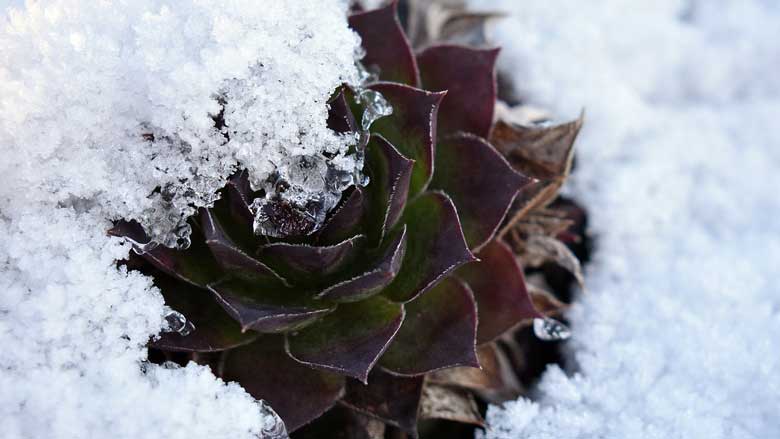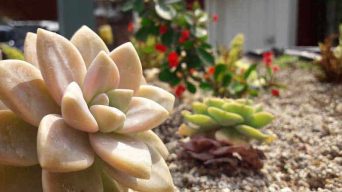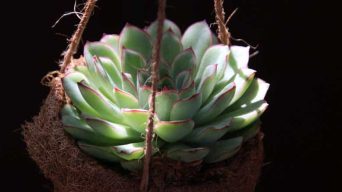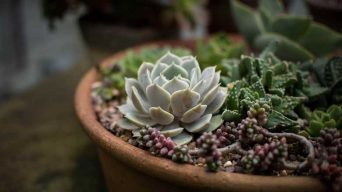To care for succulents in winter, protect them from freezing temperatures by bringing them indoors or moving them to a protected area. Ensure the soil is well-drained, and add sand if too much moisture accumulates. Water sparingly and keep an eye out for frost damage.
It’s no secret that succulents are some of the easiest plants to care for. They can thrive in various climates and don’t require much maintenance.
However, winter can be a difficult time for succulents. The cold weather and lack of sunlight can cause them to die.
Therefore, winter care for succulents is essential for keeping them healthy and alive.
This article will provide a complete guide on how to care for succulents in winter.
We will discuss protecting them from the cold weather, keeping them hydrated, and ensuring they survive until spring!
Soft vs. Hardy Succulents
The first step in caring for succulents in winter is knowing which plant you have.
There are two main types of succulents: soft and hardy.
Soft succulents, also known as tender succulents, are native to warm climates and can’t tolerate cold weather.
They will need to be brought indoors during the winter season.
Common soft succulents include Echeverias, Aeoniums, Crassulas, Haworthias, and Senecios.
Hardy succulents, on the other hand, can survive in colder climates. They don’t need to be brought indoors and can withstand freezing temperatures.
Most cold-hardy succulents can withstand down to -20 degrees Fahrenheit.
Some common hardy succulents include Sedums and Sempervivums.
Knowing which type of plant you have is crucial because it will dictate how you care for it during the winter months.
Protecting Your Succulents From the Cold
If you have a soft succulent, you’ll need to take extra precautions to protect it from the cold weather.
The best way to do this is to bring it indoors to stay warm.
When To Bring Succulents Inside for the Winter
The most important thing to remember when caring for succulents in winter is to know when to bring them inside.
This will vary depending on where you live and what type of succulent you have, but generally, it’s best to err on the side of caution and bring them inside before the first frost hits.
This will be at the end of September in most parts of the US.
Generally, most succulents can stay outside until the temperature dips below 30 degrees Fahrenheit.
However, there are a few exceptions. For example, if you have an Echeveria or other tender succulent, it’s best to bring them inside when the temperature falls below 50 degrees Fahrenheit.
Once you know when to bring your succulents inside, the next step is to actually do it!
How To Bring Succulents Inside for the Winter
If you’re bringing your succulents inside for the winter, there are a few things you need to do to ensure they stay healthy.
Water Them Before You Bring Them In
The first thing you need to do is water your succulents before bringing them inside.
This will help them adjust to their new environment and prevent them from going into shock.
Water them 2 or 3 days before you bring them inside, and ensure the soil is completely dry before you move them.
Make Sure They Have a Well Draining Soil
The second thing you need to do is make sure your succulents have well-draining soil.
Succulents don’t like to sit in wet soil, so you must use a potting mix that drains well.
A cactus potting mix or a succulent soil mix will work well, or you can make your own mix by combining potting soil, perlite, and sand.
Remove Dead Leaves and Flowers
The third thing you need to do is remove any dead leaves or flowers from your succulents.
This will help prevent them from rotting and getting diseases.
You can use a sharp knife or scissors to cut the dead leaves off, but be careful not to damage the healthy ones.
Also, remove any debris, like leaves or flowers, that has fallen onto the soil.
Prune if Necessary
The fourth thing you need to do is prune your succulents if necessary.
Pruning will help them stay healthy and look good all winter long.
If you notice any succulents that have grown excessively or if the leaves appear wilted or in poor health, feel free to trim them.
Inspect for Pests
The fifth thing you need to do is inspect your succulents for pests, so you don’t bring any inside with you.
Pests like aphids, mealybugs, and spider mites love to feast on succulents, so checking them regularly is important.
If you see any signs of pests, treat them immediately with an organic pesticide or insecticidal soap.
Give Them Time To Adjust
After you’ve brought your succulents inside, give them a few days to adjust to their new surroundings.
They might not look too happy initially, but as long as they’re in a well-lit spot and have well-draining soil, they’ll be fine.
Just be patient and take care of them by following the tips below, and they’ll soon start to thrive indoors.
Caring for Succulents Indoors in the Winter
Once you’ve brought your succulents inside, there are a few things you need to do to make sure they stay healthy all winter long.
Place Them in a Bright, Sunny Spot
One of the most important things to remember is to place your succulents in a bright, sunny spot.
The best location is near a window where they get bright, indirect sunlight.
During winter, the days are shorter, and the sun is weaker, so giving them as much light as possible is important.
If you can’t find a spot near a window, you can also use grow lights to give them the light they need.
Water Them When the Soil is Dry
Another essential thing to remember is to water your succulents when the soil is dry.
Succulents store water in their leaves, so they don’t need to be watered as often as other plants.
They might not need to be watered more than once a month during winter, depending on the temperature and how much light they’re getting.
As a general rule, water them only when the soil is dry.
Don’t Let Them Sit in Water
It’s also important to ensure your succulents don’t sit in water.
If they do, the roots will rot, and the plant will die.
To avoid this, use a well-draining potting mix and a pot with drainage holes.
You can also add a layer of gravel or rocks to the bottom of the pot to help with drainage.
A well-draining cactus mix will help prevent waterlogging. However, if you’re still worried about it, you can always put a layer of gravel or rocks at the bottom of the pot.
Don’t Fertilize Them
Finally, don’t fertilize your succulents during winter.
They don’t need it, and it might even harm them.
If you want to fertilize succulents, wait until their growing season.
Provide Good Air Circulation
Last but not least, make sure you provide good air circulation for your succulents.
They need to be able to breathe, so don’t overcrowd them in a container, and make sure there’s plenty of room for air to circulate between the plants.
Good airflow will help prevent fungal diseases, which can be a problem during winter.
Caring for Succulents Outdoors in the Winter
If you live in an area that doesn’t get too cold, you can keep your succulents outdoors during winter.
However, there are a few things you need to do to make sure they stay healthy.
Water Them Less
Most succulent plants are dormant during winter, so they don’t need to be watered as often.
During the winter months, reduce watering to once every few weeks or even once a month.
You can know when to water them again by checking the soil. When it feels dry, it’s time to water your succulents.
Place Them in a Sunny Spot
Succulents need sunlight to grow, so ensure they’re in a spot where they can get plenty of light.
The best place to keep them is in a sunny spot where they will get at least six hours of sunlight daily.
If you live in an area with short days and long nights, you may need to place your succulents under artificial lights for a few hours each day.
Protect Them From Frost
If you live in an area where it gets cold and there’s a risk of frost, you need to take some extra precautions.
You’ll need to cover your succulents with a frost cloth or any blanket that will keep them warm and let them breathe.
Avoid plastic, as it will trap moisture and cause your succulents to rot.
Make sure to remove the frost cloth during the day so they can get some sunlight.
Mulch Them
Another thing you can do to protect your succulents during winter is to mulch them.
Mulching will help keep the soil warm and prevent it from freezing.
You can use various mulch materials, such as straw, leaves, or bark chips.
Just make sure to keep the mulch away from the plant’s stem so it doesn’t rot.
Watch for Pests
In the winter, succulents are more prone to pests like mealybugs and aphids.
To prevent them from infesting your plants, check them regularly and remove any pests you see.
You can also use a mixture of water and soap to spray on the leaves, killing the pests.
Check on Them Regularly
Even if you take all the precautions, there’s always a chance that your succulents might get sick or injured during winter.
So it’s essential to check on them regularly and look for any signs of problems.
If you see anything wrong, take action immediately to prevent your succulents from dying.
Frost Damage on Succulents
One of the most common issues succulent owners face in winter is frost damage.
Frost can cause succulent leaves to turn brown and die off and kill the plant if the temperature dips too low. I
f you live in a colder climate, it’s important to protect your succulents from frost damage.
Bringing them indoors is the best way to protect your succulents from frost damage.
If you can’t bring them inside, try to place them in a sheltered spot where they won’t be exposed to the elements.
You can also cover them with a light cloth or blanket to help insulate them from the cold.
If your succulents have already been damaged by frost, there’s not much you can do to save them.
However, you can try trimming off the damaged leaves and branches and placing the succulents in a sunny spot.
Be sure not to water the succulents for a few weeks to allow them to recover.
It can take a while for frost-damaged succulents to recover, but they should eventually start to grow new leaves with proper care.
Final Thoughts
Growing succulents can be a very rewarding experience.
They are easy to care for and can add a lot of beauty to your home.
However, it is important to remember that succulents need special care during the winter months.
Following the tips in this article, you can ensure that your succulents stay healthy and happy all winter long.







